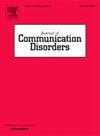Is simpler better? Semantic content modulates the emotional prosody perception in Mandarin-speaking children with autism spectrum disorder
IF 2.1
3区 医学
Q2 AUDIOLOGY & SPEECH-LANGUAGE PATHOLOGY
引用次数: 0
Abstract
Introduction
It is still under debate whether and how semantic content will modulate the emotional prosody perception in children with autism spectrum disorder (ASD). The current study aimed to investigate the issue using two experiments by systematically manipulating semantic information in Chinese disyllabic words.
Method
The present study explored the potential modulation of semantic content complexity on emotional prosody perception in Mandarin-speaking children with ASD. Two emotional prosody identification tasks were designed, in which different levels of prosodic and lexical complexity were incrementally included in four stimulus types: pseudo-words, semantically-neutral words, semantics-prosody congruent, and incongruent emotion words. Twenty-four children with ASD and twenty-two typically developing (TD) children were required to focus on the prosodic channel to label emotions while ignoring the semantic information.
Results
Emotionally neutral semantic content exerted little negative influence on the ASD group's accuracy, while semantic-prosodic incongruence in emotion-label words had dramatic adverse impacts. Although distinct emotional prosody identification patterns were observed across the two groups, the confusion matrices suggested that the participants with ASD had developed similar patterns in identifying the five prosodies.
Conclusions
Children with ASD demonstrated a stronger adverse impact from the incremental complexity in the overlap between prosody and lexical cues. However, notably, they have tended to develop a typical emotional prosody recognition pattern. Thus, the poorer performance in the ASD group might originate from the possible developmental delay in suppressing semantic interference rather than from inherent emotion-specific impairments.
越简单越好吗?语义内容调节汉语自闭症谱系障碍儿童情绪韵律感知。
语义内容是否以及如何调节自闭症谱系障碍(ASD)儿童的情绪韵律感知仍存在争议。本研究通过对汉语双音节词的语义信息进行系统处理,探讨了这一问题。方法:探讨语义内容复杂性对汉语自闭症儿童情绪韵律感知的潜在调节作用。设计了两项情绪韵律识别任务,在四种刺激类型中,分别是假词、语义中性词、语义韵律一致词和语义韵律不一致词,逐级增加不同程度的韵律和词汇复杂性。24名ASD儿童和22名正常发育儿童(TD)被要求专注于韵律通道来标记情绪,而忽略语义信息。结果:情绪中性的语义内容对ASD组的准确性影响不大,而情绪标签词的语义韵律不一致对ASD组的准确性有显著的不利影响。尽管在两组中观察到不同的情绪韵律识别模式,但混淆矩阵表明,患有ASD的参与者在识别五种韵律方面形成了相似的模式。结论:随着韵律线索和词汇线索重叠程度的增加,ASD患儿表现出更强的不利影响。然而,值得注意的是,他们倾向于发展一种典型的情绪韵律识别模式。因此,ASD组较差的表现可能源于抑制语义干扰的发育迟缓,而不是固有的情绪特异性障碍。
本文章由计算机程序翻译,如有差异,请以英文原文为准。
求助全文
约1分钟内获得全文
求助全文
来源期刊

Journal of Communication Disorders
AUDIOLOGY & SPEECH-LANGUAGE PATHOLOGY-REHABILITATION
CiteScore
3.30
自引率
5.90%
发文量
71
审稿时长
>12 weeks
期刊介绍:
The Journal of Communication Disorders publishes original articles on topics related to disorders of speech, language and hearing. Authors are encouraged to submit reports of experimental or descriptive investigations (research articles), review articles, tutorials or discussion papers, or letters to the editor ("short communications"). Please note that we do not accept case studies unless they conform to the principles of single-subject experimental design. Special issues are published periodically on timely and clinically relevant topics.
 求助内容:
求助内容: 应助结果提醒方式:
应助结果提醒方式:


